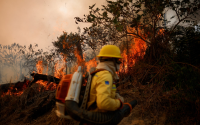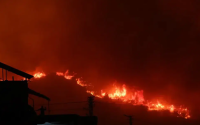Common Dreams / Published on Monday, December 3, 2007 by The Independent/UK
Rich countries are rapidly increasing the pollution that causes global warming to record levels - despite having solemnly undertaken to reduce it, three devastating new official reports reveal. Emissions of greenhouse gases and their accumulation in the atmosphere are higher than they have ever been, and unless policies are urgently reversed “catastrophic” climate change is inevitable, they warn.
The reports - from three separate UN organisations - form the strongest and most authoritative condemnation of Western climate policies yet.
They are made public as representatives of nearly 200 governments fly into Bali, Indonesia, this weekend for the most crucial negotiations on global warming for years. The talks, which open tomorrow, are to start discussing a successor to the present agreement under the Kyoto Protocol, which runs out in five years’ time, having failed to measure up to the escalating climate crisis. Experts say it is the world’s “last chance” to avoid disaster.
And they follow the harshest warning yet from the congenitally cautious official Intergovernmental Panel on Climate Change. Its latest report predicted that, if present trends continue, harvests in much of Africa could be halved by 2020, the Amazon rainforest will turn to dry savannah, and the Greenland icecap will completely melt, raising sea levels worldwide by over 30ft.
The first of the new reports, by the UN Framework Convention on Climate Change (UNFCCC), the body organising the Bali conference, shows that total emissions of greenhouse gases - mainly carbon dioxide, methane and nitrous oxide - by the world’s 40 industrialised nations have risen to “to an all-time high”, although they are supposed to be diminishing under the Kyoto Protocol.
Under the 1997 Kyoto treaty, rich nations undertook to cut emissions of the gases by a modest total of about 5 per cent of 1990 levels by 2012. But, 10 years later, the report shows that the Westernised economies that signed up to it have instead increased them by 11 per cent.
Pollution by the former Eastern Bloc countries - whose economies collapsed after the fall of the Berlin Wall - has been steadily increasing. Besides, the US and Australia - the two industrialised countries that rejected the treaty - have both vastly increased emissions and they have also risen sharply in key developing countries such as China and India.
The result is spelled out in the second report, by the World Meteorological Organisation (WMO), which concludes that concentrations of both carbon dioxide and nitrous oxide in the atmosphere have reached record levels - causing the planet to heat up faster than ever before.
The WMO’s annual Greenhouse Gas Bulletin shows that the amount of carbon dioxide - the main greenhouse gas, responsible for about two-thirds of man-made global warming, mainly released by burning fossil fuels - jumped by some 2 per cent last year, one of its sharpest-ever rises. The rate of increase has accelerated markedly since the 1990s. Concentrations are now 36 per cent higher than during the 10,000 years leading up to the beginning of the industrial revolution.
Nitrous oxide - which also comes from burning fossil fuels, as well as from fertiliser and some industrial processes - is also at an all-time high, up 19 per cent from pre-industrial times.
Levels of methane - from rubbish tips, cattle and rice paddies as well as fossil fuels - fell slightly - but increased by 250 per cent since the industrial revolution.
Together, the heating of the Earth by greenhouse gases has grown by 22.7 per cent since 1990.
The third report, the United Nations Development Programme’s Human Development Report, says: “If the next 15 years of emissions follow the linear trend of the past 15, dangerous climate change will become unavoidable.
“On the basis of current trends and present policies, concentrations of carbon dioxide could rise by more than 50 per cent over 2005 levels by 2030¨.
It goes on: “Political action continues to fall far short of the minimum needed to resolve the climate change problem. The gap between scientific evidence and political response remains large.” It adds that most of the rich countries that have signed up to Kyoto “are off track for achieving their commitments”.
Both it and the UNFCCC report name names. They show, for example, that the two industrialised countries that have abjured the treaty have both massively increased emissions of greenhouse gases. The United States has swelled them by 16 per cent, and Australia by 25 per cent, over 1990 levels.
But some countries that have undertaken to observe Kyoto, such as Ireland, Canada, Greece, Spain and Portugal, have performed even worse. Each party to the treaty was set its own binding target. But only four countries - Germany, France, Sweden and Britain - are on track to meet them.
Even some of those that are on course can thank other factors besides conscious policies. Germany owes four-fifths of its reductions to the restructuring of the east of the country’s economy following reunification, though it has since introduced radical measures to save energy and to promote renewable sources such as solar power.
Britain, which has taken few such steps, comes in for particular criticism in the UNDP report, exploding ministers’ constant claims to be “leading the world” in tackling global warming. The report points out, as frequently argued by The Independent on Sunday, that the UK achieved its cuts by switching away from coal following Mrs Thatcher’s defeat of the miners, and that emissions have actually risen since Labour came to power.
Environmentalists hope that the talks that start tomorrow in Bali will usher in something much better, before it is too late. Philip Clapp, head of the Washington-based National Environment Trust, says: “Fifteen years of international negotiations have not yet produced a comprehensive agreement that will get developed countries to begin serious reductions.”
He adds: “The framework for such an agreement must come out of the Bali meeting. The scientists are telling us that this is the world’s last shot at avoiding the worst consequences of global warming.”
In figures: World heading for carbon saturation
If everyone on Earth emitted as much greenhouse gas as North Americans, we would need nine atmospheres to absorb it all safely.
At the present rate the world will, within the next 25 years, emit the entire amount of carbon dioxide that the atmosphere can safely take over the entire 21st century.
Rich countries are responsible for seven out of every 10 tons of carbon dioxide emitted since the industrial revolution.






